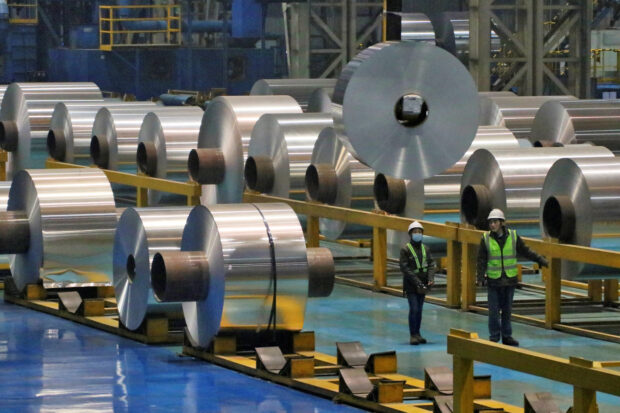Asia’s factories squeezed as China’s nascent recovery teeters

Employees work at the production line of aluminum rolls at a factory in Zouping, Shandong province, China Nov 23, 2019. REUTERS/Stringer/File photo
TOKYO – Asia’s manufacturers faced worsening pressure in October with factory activity in China slipping back into decline, clouding recovery prospects for the region’s major exporters already squeezed by weaker global demand and higher prices.
Purchasing managers’ indexes (PMIs) for factory powerhouses China, Japan and South Korea showed activity shrinking while Vietnam and Malaysia also struggled with the broadening fallout from a Chinese slowdown.
China’s Caixin/S&P Global manufacturing PMI fell to 49.5 in October from 50.6 in September, a private sector survey showed on Wednesday, falling back below the 50.0 point threshold that separates growth from contraction.
The Chinese survey echoed a downbeat official PMI reading on Tuesday, which also showed an unexpected contraction in activity, casting doubt over recent hopes of a recovery in the world’s second-largest economy.
“Overall, manufacturers were not in high spirits in October,” said Wang Zhe, an economist at Caixin Insight Group, on China’s survey outcome.
Article continues after this advertisement“The economy has showed signs of bottoming out, but the foundation of recovery is not solid. Demand is weak, many internal and external uncertainties remain, and expectations are still relatively weak.”
Article continues after this advertisementThe impact of China’s slowdown is being felt in countries like Japan and South Korea, whose manufacturers are heavily reliant on demand from the Asian giant.
Japan’s factory activity shrank for a fifth straight month in October, the final au Jibun Bank PMI showed.
That came a day after official figures showed Japan’s factory output rose much less than expected in September as demand slowed significantly.
Japanese machinery makers like Fanuc and Murata Manufacturing recently reported weak six-month earnings due to sluggish Chinese demand.
South Korea’s factory activity fell for the 16th straight month while PMIs from Taiwan, Vietnam and Malaysia also showed continued declines in activity.
The International Monetary Fund (IMF) has warned that China’s weak recovery and the risk of a more protracted property crisis could further dent Asia’s economic prospects.
In its World Economic Outlook released last month, the IMF cut next year’s growth estimate for Asia to 4.2 percent from 4.4 percent projected in April, and down from 4.6 percent forecast for this year.